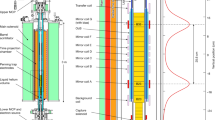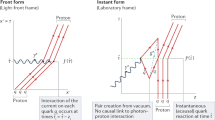Abstract
A CRUCIAL test of a relativity theory of gravitation is its ability to explain (a) the perihelion advance of a planetary orbit as observed in the case of Mercury, and (b) the deflexion of light in a gravitational field as observed in the field of the sun. Another, completing the trio of tests which Einstein's general theory satisfied with such notable success, is in a different category, since it involves some hypothesis concerning the ‘proper’ frequencies of atomic vibrations; this is (c) the shift of the spectral lines emitted by atoms near a massive body, as observed in the case of light from the sun and from the companion to Sirius. It is not difficult to apply tests a and b to the gravitational part of Milne's theory1, assuming that the equations of motion given by Milne hold in the field of the sun. The results are that, first, there is a perihelion motion, but it is in the wrong direction, and secondly, there is no gravitational deflexion of light. The failure under the first test could perhaps be accounted for by the fact that the sun is not at rest in the substratum; but if this were so, the perihelion effect would depend critically upon the sun's velocity relative to the substratum and upon the orientation of the planetary orbit under consideration. On the whole, it appears that Milne's dynamical theory does not compare favourably with Einstein's general theory.
This is a preview of subscription content, access via your institution
Access options
Subscribe to this journal
Receive 51 print issues and online access
$199.00 per year
only $3.90 per issue
Buy this article
- Purchase on Springer Link
- Instant access to full article PDF
Prices may be subject to local taxes which are calculated during checkout
Similar content being viewed by others
References
For an account of this theory, see Milne, E. A., “Kinematic Relativity” (Oxford, 1948).
Walker, A. G., review of “Kinematic Relativity”, Math. Gaz., 33, 304 (1949).
See Eddington, A. S., “Mathematical Theory of Relativity”, Chapter 3 (Cambridge, 1930).
Author information
Authors and Affiliations
Rights and permissions
About this article
Cite this article
WALKER, A. Gravitation in Kinematic Relativity. Nature 168, 961–962 (1951). https://doi.org/10.1038/168961a0
Issue Date:
DOI: https://doi.org/10.1038/168961a0
This article is cited by
-
Self-coupled scalar gravitation
General Relativity and Gravitation (1970)
-
General Relativity and Lorentz-Invariant Theories of Gravitations
Nature (1960)
Comments
By submitting a comment you agree to abide by our Terms and Community Guidelines. If you find something abusive or that does not comply with our terms or guidelines please flag it as inappropriate.



